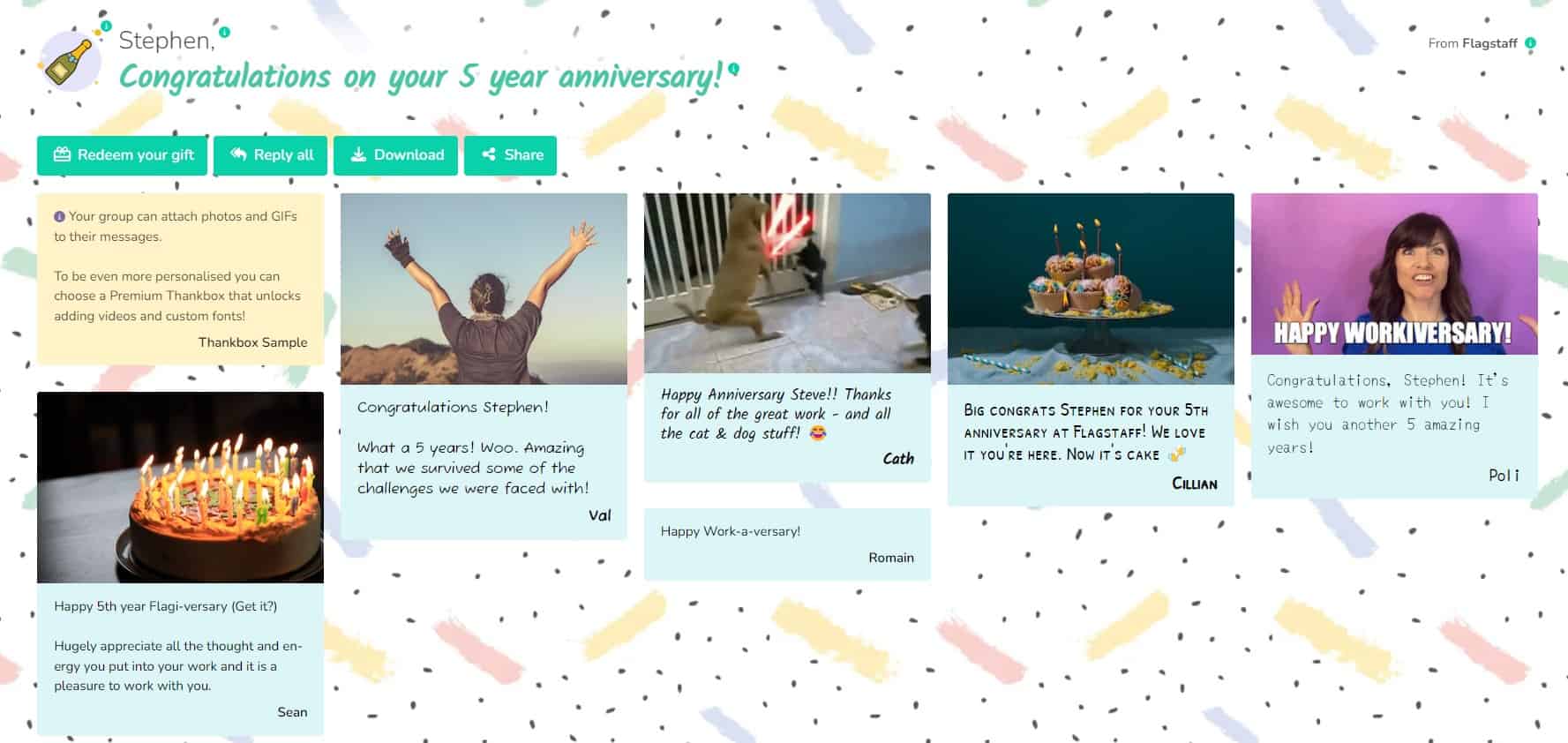Here’s How to Create Employee Development Plans That Inspire & Drive Success


As any manager worth their salt knows—the success of your business hinges on your employees. If you don’t have the right people behind the wheel, thriving in today’s competitive landscape becomes impossible.
Even with the most innovative strategies, ample resources, and cutting-edge technology that would make even Elon Musk jealous, you need a talented and motivated team to drive your business forward.
But here’s the challenge—retaining top talent isn’t easy. With so many opportunities out there, if your employees aren’t happy, they can leave for greener pastures. Here’s where employee development plans come into play.
In this article from Thankbox—we’ll explore employee development plans, why they matter, as well as how to create effective personalised development plans that’ll make your team feel inspired and appreciated.
Let’s dive in!
What are employee development plans?
Employee development plans are all about continually improving an employee’s skills, knowledge, and abilities. It’s a proactive strategy that syncs up personal development with company goals, making sure team members are prepared for their current roles and geared up for future challenges.
An employee development plan (EDP) should act as a roadmap for progression—focusing on the following:
Clear objectives: Establishing measurable goals that go hand-in-hand with both the employee’s career aspirations and the organisation’s needs.
Tailored training programmes: Designing training sessions, courses, and workshops that address the unique needs of each staffer.
Mentorship and coaching: Providing access to mentors and coaches who can offer guidance, support, and valuable industry insights.
Regular feedback: Putting into action a system for continuous feedback to track progress, address challenges, and make necessary adjustments.
Evaluation and revision: Periodically reviewing the plan’s effectiveness and making adjustments where needed.
Why are employee development plans so important?
We’ve all had the experience of feeling stuck—like we’re wasting our skills and opportunities are non-existent. In fact, just under 50% of employees say they lack career support from their managers—employee development plans ensure you’re not one of them.

EPDs are a vital piece of the puzzle for long-term success. With an action plan in place, employees can improve their skills, progress in their careers, and enhance job satisfaction. Additionally, it’s a great asset for your company, as you have a pool of promotable and engaged staff!
Let’s take a closer look:
Employee engagement: Individuals are much more likely to be engaged and satisfied when they feel appreciated and nurtured, and employee development plans demonstrate that the company is genuinely investing in its employees.
Upskilling: Technology is transforming the workplace, and the half-life of skills is getting shorter. Companies should upskill employees to close the skill gap, retain talent, and enhance insight into their customers and culture—ideal for driving success.
Improves retention rates: High turnover is costly and disruptive. With clear pathways for career growth, companies can boost employee retention rates. After all, who would want to leave a company that invests in them?
Aligns personal and organisational goals: When employee development aligns with company goals—everyone moves in the same direction. This synergy means the company achieves its objectives while employees advance in their careers, creating a win-win situation.
Succession planning: EDPs play a large role in developing future leaders. By identifying and nurturing potential candidates, organisations enjoy a strong pipeline of talent ready to step up.
Whether it’s completing a certification or hitting a sales target within their employee development plan, sending a Thankbox is the perfect way to recognise your team’s efforts. Create a Thankbox today and show your employees just how much you value their hard work and dedication!
How to create an effective development plan for an employee?
As with most things, collaboration plays a huge role in designing an employee development plan. As all EDPs are unique to the individual, input from both managers and team members is essential to maximising their effectiveness.
Here are some steps to creating a winning employee development plan:
1. Assess your company’s needs
First things first—figure out what you want to achieve with your employee development plan. Look at both your business’s needs and the actionable career goals of your team members.

Ask yourself the following questions:
Do we have knowledge or skill gaps?
Is our training and development aligned with our strategic needs?
Are our benefits aligned with employee priorities?
How do we measure and improve employee satisfaction?
The idea is to gain as much insight as possible into your company and employees. Collect feedback from your teams, managers, and stakeholders via questionnaires, analyse industry trends, and review business performance metrics to identify underperforming areas.
2. Uncover employee goals and skills
Now, let’s focus on the individuals. It’s impossible to create a personalised development plan without first understanding your employees’ career aspirations and skill sets.
Start by holding one-on-one meetings with each staff member and use assessments and performance reviews to identify strengths, weaknesses, and needs. Clarify their responsibilities and practice active listening.
The aim is to understand their aspirations within your company and identify what’s holding them back. If you need a starting block, check out the following:
What skills do you need for your job?
Do you have what you need to perform your best?
What would help you improve your performance?
Are there other roles in our organisation that interest you?
What would help you progress further?
3. Set clear, achievable objectives
Next up, establish specific, measurable, achievable, relevant, and time-bound (SMART) objectives based on the information above. This isn’t a solo venture—collaborate with your employees so their targets are realistic and aligned with their professional goals.
Some examples of SMART goals include delivering a training session for new hires by the end of the year, or completing a certification programme in your field within the next six months.
Clear goals give employees something concrete to strive for. When goals are well defined, it’s easier to understand exactly what to expect and how it contributes to personal growth.
Celebrate every success story with Thankbox!
When employees reach significant milestones in their development plans, such as completing a certification, hitting a sales target, or successfully leading a project, sending a Thankbox online group greeting card is the perfect way to recognise their efforts.

Thankbox allows you and your team to contribute personalised messages, photos, and videos to your cards. Plus, if you can’t think of what to say, don’t worry, you can even add GIFs!
No more discreetly passing a card around the office and waiting for everyone to sign—someone always forgets! With Thankbox, simply share a link, and you’re good to go!
Want to add an extra touch? Thankbox offers flower delivery and digital gift cards, making it as easy as pie to say congratulations on a job well done. Celebrate your team’s achievements in a meaningful and memorable way with Thankbox.
4. Create customised and personalised development plans
One size doesn’t fit all when it comes to employee development plans. Customised strategies address the specific needs and aspirations of each individual. So, tailor the content to be relevant and engaging, and more importantly, align it with your employees’ career goals.
It’s not enough just to provide them with a list of objectives—you must remove barriers and supply the tools they need to succeed—it’s a perfect way to demonstrate your support!
You can offer a mix of these tools and resources:
Learning management systems (LMS): LMS platforms streamline the learning process with a centralised location for training materials, tracking progress, and managing certifications.
Online courses and workshops: These flexible learning opportunities, available on platforms like Coursera and LinkedIn Learning, allow employees to work at their own pace.
Books and journals: Encourage staff members to read industry-related books and journals to stay up-to-date on the latest trends.
Industry conferences and networking events: Attending industry-specific events offers the chance for your employees to learn from experts, gain new insights, and expand their contacts.
5. Monitor progress and provide feedback
A central part of a successful employee development plan is regularly checking in—seeing how things are going and tweaking actions and goals as needed. Follow a structured approach to assess feedback—self-reports and surveys are ideal here.

Managers should regularly meet with each employee to chat about progress, celebrate wins, and plan next steps. During these conversations, consider:
What progress have you made towards your goals since our last meeting?
Are there any specific skills you feel you need to develop further?
How do you feel about your current workload?
Are there any resources or support you need to achieve your goals?
Have any changes in your team impacted your development plan?
6. Revise plans as necessary
Revising employee development plans guarantees they stay relevant and, above all else—effective. Regularly review and adjust goals based on progress, new opportunities, or changes in circumstances. Keep detailed records of all changes and the reasons behind them.
Remember, things change. Maybe one of the goals you set no longer makes sense, or your approach isn’t working as expected. Flexibility is everything—without adapting and updating the plan as needed, it’ll be tougher to support your employees’ progress.
Common challenges with employee development plans & how to overcome them
Designing effective employee development plans comes with its own set of challenges. Here are some common obstacles and strategies to tackle them:
Resistance to change
Resistance to change is a common hurdle in employee development. Employees might be comfortable with their current roles and wary of new processes.
To overcome this—communicate the benefits of development plans clearly. Involve team members in the planning process and provide support throughout their journey. Highlight success stories and offer incentives to motivate participation.
Building strong professional bonds goes a long way. When employees trust their managers and peers, they’re more open to new ideas. It’s much easier to embrace change when you feel part of a supportive team.
Whether it’s completing a certification or hitting a sales target within their employee development plan, sending a Thankbox is the perfect way to recognise your team’s efforts. Create a Thankbox today and show your employees just how much you value their hard work and dedication!
Limited resources
Limited resources, whether budgetary or time-related, can stop the implementation of your plans. To combat this, prioritise development activities that offer the most significant impact.

Leverage cost-effective solutions like online courses, webinars, and internal training sessions. Additionally, seek collaborations with educational institutions or industry experts to provide valuable training at a lower cost.
Balancing development with the daily 9-to-5
Employees often struggle to balance their development activities with daily responsibilities. To address this and avoid the chances of burnout or disengagement—integrate development activities into their regular workflow.
Schedule training sessions during less busy periods and set realistic timelines for achieving development goals. Encourage managers to support their team members and repeat the importance of a healthy work-life balance.
Employee development plan template
Here’s a detailed EDP template to help you get started:
Goals: Define their specific goals and objectives. These should align with both their career aspirations and your organisation’s objectives. Clear, actionable goals are better.
Timeline: Set a realistic timeframe and include intermediate milestones to track progress and maintain motivation. Deadlines help build consistency.
Resources: Identify all the resources they’ll need to accomplish their tasks—including time, budget, training programmes, mentors, and access to specific tools or technology. Make sure these resources are available when needed.
Action steps: Outline each step they’ll take to reach their goals. This might involve attending workshops, participating in training sessions, or working closely with a mentor.
Performance metrics: Determine how to measure progress. Use both qualitative and quantitative metrics to get a 360-degree view of development. Examples include completing specific projects or gaining new certifications.
Review: Schedule regular check-ins to review progress and provide feedback. These sessions should be used to celebrate achievements, address any challenges, and adjust the development plan as needed.
Adjustments: Be prepared to make adjustments to the plan. While it can be time-consuming, regularly revisiting and revising the plan means it stays relevant.
Documentation: Maintain detailed records such as initial assessments, goals, resources, action steps, and performance metrics. Proper documentation ensures transparency.
Wrapping up
As you can see, an employee development plan works wonders for both your employees and your organisation. After all, no one wants to stay in the same role indefinitely—people crave opportunities to learn, embrace new challenges, and grow in their careers.
That’s exactly what EDPs are for—they show your staff that you’re investing in their future and value their hard work and dedication. And when it comes to acknowledging that effort, Thankbox makes it easy.
Create a Thankbox today and show just how much you appreciate them!
Images: Cover | Woman sitting by a brown wooden table | Question marks on craft paper | Colleagues working together and drinking tea | Smiling co-workers





